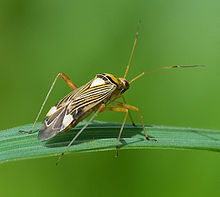- Miridae
-
"Leaf bug" redirects here. For the insect that resembles a leaf, see Phylliidae.
Miridae 
Rhabdomiris striatellus Scientific classification Kingdom: Animalia Phylum: Arthropoda Class: Insecta Order: Hemiptera Suborder: Heteroptera Family: Miridae
Hahn, 1831Genera Over 1,000 including:
The large and diverse insect family Miridae contains the plant bugs, leaf bugs, and grass bugs, and may also be known as capsid bugs. It is the largest family of true bugs belonging to the suborder Heteroptera, with over 10,000 known species and new ones constantly being described. They are small, terrestrial insects, usually oval-shaped or elongate and measuring less than 12 millimetres (0.5 in) in length. Some are brightly coloured, others drab or dark. Some genera are ant mimics at certain stages of life. Most of the more well-known mirids have received attention because they are agricultural pests. They pierce plant tissues and feed on the juices.
Some mirid species:
- Lygus bugs (Lygus spp.), including the tarnished and western tarnished plant bugs, are serious pests in the cotton, strawberry, and alfalfa industries.
- Stenotus binotatus, a minor pest of cereal crops, especially wheat
- Apple dimpling bug (Campylomma liebknechti) damages apple blossoms and small growing fruits.
- Mosquito bugs Helopeltis spp. - that infest various crops including tea, cacao and cotton
- Honeylocust plant bug (Diaphnocoris chlorionis) damages foliage on honeylocust trees.
- Green mirid (Creontiades dilutus) damages many types of field crops.
- Potato mirid (Calocoris norvegicus) is a noted pest of potato and clover plants in New Zealand.
- Deraeocoris nebulosus prefers other insects to plants in its diet, and has been used as a biocontrol agent against mites and scale insects.
External links
- PBI Plant Bug Index
- Link to Al Wheeler's book on the biology of mirids
- Research of Phylinae of Southern California at UC Riverside
- Garden fleahopper on the University of Florida / Institute of Food and Agricultural Sciences Featured Creatures website

This article related to members of the insect order Hemiptera is a stub. You can help Wikipedia by expanding it.
